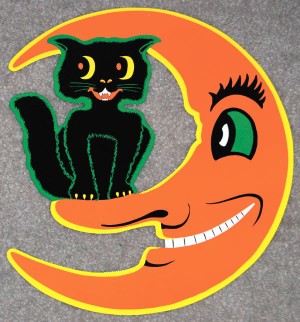The pumpkins are carved, bags of mini chocolate bars are stacking up and the neighbors lawn is covered with cobwebs and tombstones. Yes, it is once again Halloween season!
While for many the spookiest of all holidays comes each year at the end of October, there are those who are in full “ghost and goblin” mode 12 months a year. Halloween collectibles are growing in popularity, and the search is on!
The time frame 1900-1935 is considered the “golden era” of Halloween memorabilia. Cardboard lanterns, postcards, sheet music, candy containers, witch dolls and even party boxes were all made during this time with typical Halloween depictions. These early pieces, particularly those in good condition, are rare and valuable. At the top of the “must have” list from this era are the fine German pieces from 1919-1935. Many of the lanterns, candy containers and figurals were made in private homes or very small firms, from either a fixed design or a mold, and all were hand decorated. The quantity of items produced during this time frame was quite small, and as with many collectibles, scarcity equals dollars.
Halloween die-cuts circa 1940-1950 from The Beistle Company and Dennison Manufacturing are among the most popular of the American made Halloween collectibles. Research is a necessity in this line of collectible as the majority of these pieces, especially those from Beistle, are unmarked. One notable exception are the Beistle table items and lanterns with the “H.E. Luhrs” insignia. As you acquaint yourself with the imagery and design of Beistle pieces, identification will become easier. One aid to recognizing and dating the work of Dennison Manufacturing are the “Halloween Bogie Books” printed from 1909 to the mid-1930s. These magazines were the primary sales and marketing tool for Dennison’s Halloween products and can be found at finer antique shows specializing in holiday collectibles.
My favorite Halloween collectible are the “vegetable people.” These whimsical celluloid figures from the 1930s were made to be given out at as favors at children’s Halloween parties. They were then crushed “to drive away evil spirits.” Those that survived are demanding top dollar at specialized auctions. The Morphy’s Auction Service in Denver, Pennsylvania recently set a record when a German 17½ inch, 1930s veggie man store display sold for $19,550. Don’t anticipate finding one of these anytime soon!
Tin noisemakers, coming in great variety and ingenuity, were also made by a number of American firms. Names to watch for include Bugle Toy, Chein, Kirchhof and T. Cohn. Tambourines, clangers, rattlers, ratchets and other tin pieces from the early years will have sculpted wooden handles. Newer issues will have plastic handles.
Desirability in this field of collecting is largely determined by topic matter. In descending order of value we start with devil imagery, witches and vegetable people at the top, followed by black cats, skeletons, and owls, and lastly the pumpkin or its alter ego the Jack-of-Lantern. Since Halloween items are notoriously hard to accurately date, a good rule is, the scarier the image, the older the item!
Second in popularity only to Christmas as a holiday collectable, the memorabilia of Halloween’s past is much more difficult to find. While Christmas decor is usually packed away to be used another year, the trappings of Halloween tend to be used once and then discarded. It is this scarcity of mint condition vintage pieces that makes the collecting both challenging and rewarding. Until next time……..Linda
Irvington resident Linda Kennett is a professional estate liquidation consultant specializing in down-sizing for seniors and the valuation of antiques and household content and may be reached at 317-258-7835 or lkennett@indy.rr.com



